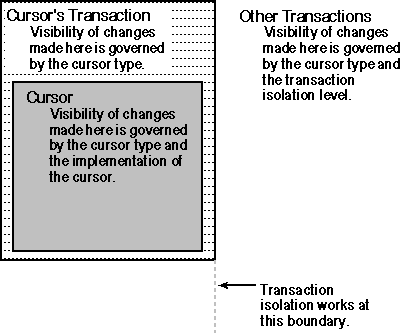
Scrollable Cursors and Transaction Isolation
The transaction isolation level dictates what changes in other transactions
might be visible to the cursor while the cursor type dictates which of those
changes are actually visible. For example, suppose the transaction containing the
cursor is running at the Read Committed isolation level: Committed changes made
by other transactions are visible to the cursor
Note that the transaction isolation level does not affect a cursor
| Changes made by:
| Visibility depends on:
|
Cursor | Cursor type, cursor implementation
|
| Other statements in same transaction
| Cursor type
|
| Statements in other transactions
| Cursor type, transaction isolation level
|

Depending on the application, certain combinations of cursor type and transaction isolation level do not make sense. For example, suppose an online telephone book uses a dynamic cursor to read and display telephone numbers and that a separate application is used to maintain the database of telephone numbers. To be effective, the cursor used to read telephone numbers needs to detect all committed changes to the database. If the transaction containing this cursor is run at the Repeatable Read or Serializable isolation level, the cursor will detect few or no changes and is essentially a slow, expensive static cursor. Instead, the transaction containing the cursor should be run at the Read Committed isolation level.
The following table summarizes the ability of each cursor type to detect changes made by itself, by other operations in its own transaction, and by other transactions. The visibility of the latter changes depends on the cursor type and the isolation level of the transaction containing the cursor.
|
| Self
| Own
Txn | Othr
Txn (RU [a]) | Othr
Txn (RC [a]) | Othr
Txn (RR [a]) | Othr
Txn (S [a]) |
Static |
|
|
|
|
|
|
| Insert
| Maybe [b]
| No
| No
| No
| No
| No
|
| Update
| Maybe [b]
| No
| No
| No
| No
| No
|
| Delete
| Maybe [b]
| No
| No
| No
| No
| No
|
| Keyset
-driven |
|
|
|
|
|
|
| Insert
| Maybe [b]
| No
| No
| No
| No
| No
|
| Update
| Yes
| Yes
| Yes
| Yes
| No
| No
|
| Delete
| Maybe [b]
| Yes
| Yes
| Yes
| No
| No
|
| Dynamic
|
|
|
|
|
|
|
| Insert
| Yes
| Yes
| Yes
| Yes
| Yes
| No
|
| Update
| Yes
| Yes
| Yes
| Yes
| No
| No
|
| Delete
| Yes
| Yes
| Yes
| Yes
| No
| No
|
[a] The letters in parentheses indicate the isolation level of the transaction containing the cursor; the isolation level of the other transaction (in which the change was made) is irrelevant. RU: Read Uncommitted RC: Read Committed RR: Repeatable Read S: Serializable [b] Depends on how the cursor is implemented. Whether the cursor can detect such changes is reported through the SQL_STATIC_SENSITIVITY option in SQLGetInfo. |